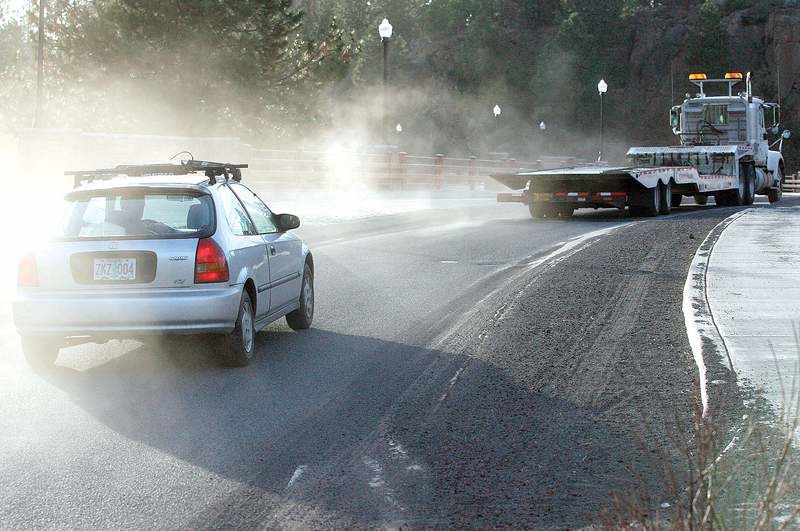Man, its dusty
Published 4:00 am Friday, January 16, 2009

- A car drives through a cloud of dust kicked up by a semi truck and trailer Thursday on the Bill Healy Memorial Bridge along Reed Market Road in Bend. City crews have been working to sweep up the cinders and crushed rock put down during recent snowstorms, but the remaining materials have created dusty conditions around Bend.
After a long stretch of unseasonably warm temperatures, the snow that piled up around Bend just a few weeks ago has all but disappeared.
But once the snow and ice melted, something else was left behind: small pieces of cinder and basalt the city’s Public Works Department spread during the storm to help make streets less slippery and break up the ice.
City officials said crews started sweeping up the materials as soon as the weather cleared, but it could be weeks before they’re able to remove all of it from the city’s roadways. In the meantime, the small particles of cinder and basalt are being picked up by tires and gusts of wind, creating a mess of dust and dirt clouds that have caught the attention of many residents.
This winter, the city has used some cinders for traction control but has switched primarily to basalt, a type of crushed rock. Hardy Hanson, Bend’s Street Division manager, said he’s received a few calls from people concerned the change has produced more dust than in the past, but he said city officials don’t think it’s worse than usual.
“We’ve had a few complaints about the dust, people saying it’s much dustier than cinders, and we don’t feel that’s the case,” he said. “There’s less fine material in the basalt than there is in the cinders.”
Hanson said the city’s tight budget situation hasn’t impacted the way it cleans up after snow melts. The typical procedure, he said, is to start sending out the street sweepers once the weather has improved and crews don’t need to be driving snowplows.
The city has seven street-sweeping machines, and Hanson said there are usually about four of them out at a time, sweeping and sucking up the dust and dirt, and depositing it at a location where it is sorted out for disposal or reuse.
So far this winter, Hanson said the city has spread about 5,000 yards of cinders and basalt, and has been able to pick up about one-fifth of that amount. He said cleaning up the materials is a process that can last all winter, depending on the weather, and how many times the city has to plow and put cinder or basalt on the roads.
“For all the time it takes to put it down, it takes at least 10 times as long to pick it up,” Hanson said.
Some residents, however, say they’re worried about the potential hazards created by all the dust flying around. Southwest Bend resident Brian Gomez said he and several of his neighbors are concerned there’s enough dust flying in the air to cause health problems.
“I notice things like even a skateboarder going down the street is kicking up a trail of dust behind him,” Gomez said.
Linda Hayes-Gorman, the manager of the Oregon Department of Environmental Quality’s Eastern Region Air Quality Program, said officials are monitoring the air in Bend but haven’t noticed any negative impact from the street dust. But she said it’s likely that some people, especially those walking or biking down busy streets, might feel some effects.
“You will have irritating dust from either cinders or whatever you’re putting down, but that size dust is typically larger in size than what will go down into the lungs,” she said. “It would be more of a respiratory irritation to the sinuses or to the eyes, but for our overall air quality, we’re not seeing (the dust) really impacting the overall air quality.”
Though the dust might not be a major health hazard, Hanson said city officials are working on plans to cut down on the problem in the future.
“We’re looking at how we can improve the process and wash the gravel so it’s a little less dirty,” he said. “We’ve already gotten some new material, and that’s where we’re headed.”
Hanson said residents will continue to see street sweepers out around the city, particularly in the early-morning hours when traffic is lighter and its easier to clean up.
“It does take us some time, but we do eventually get on top of it,” he said.






